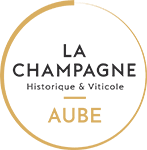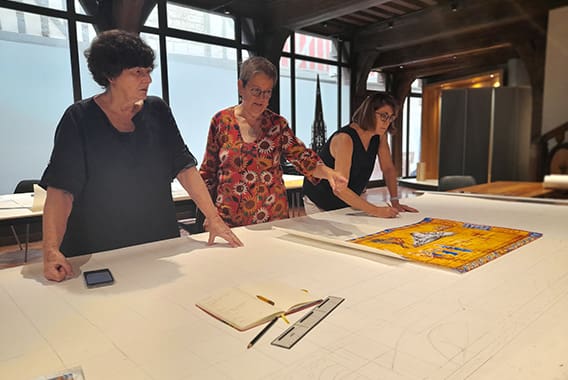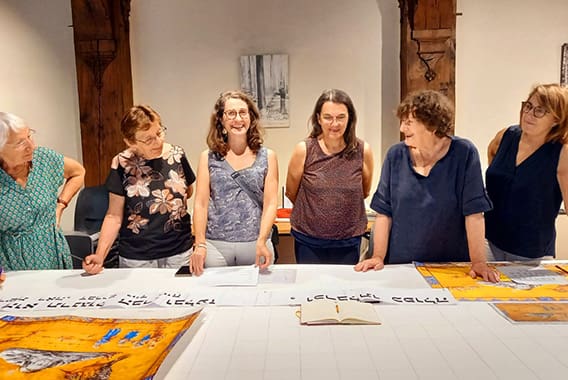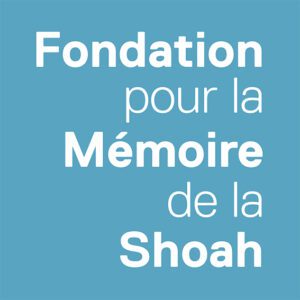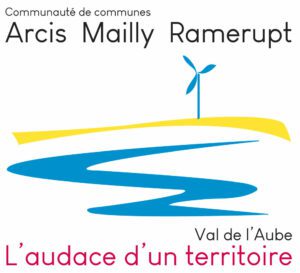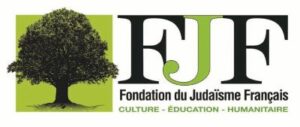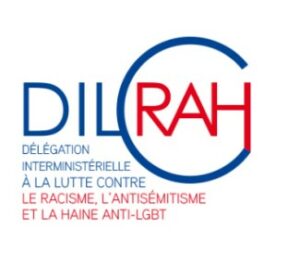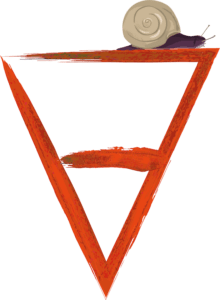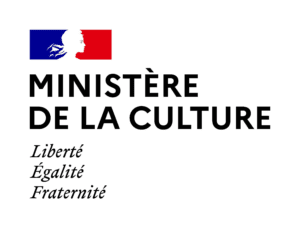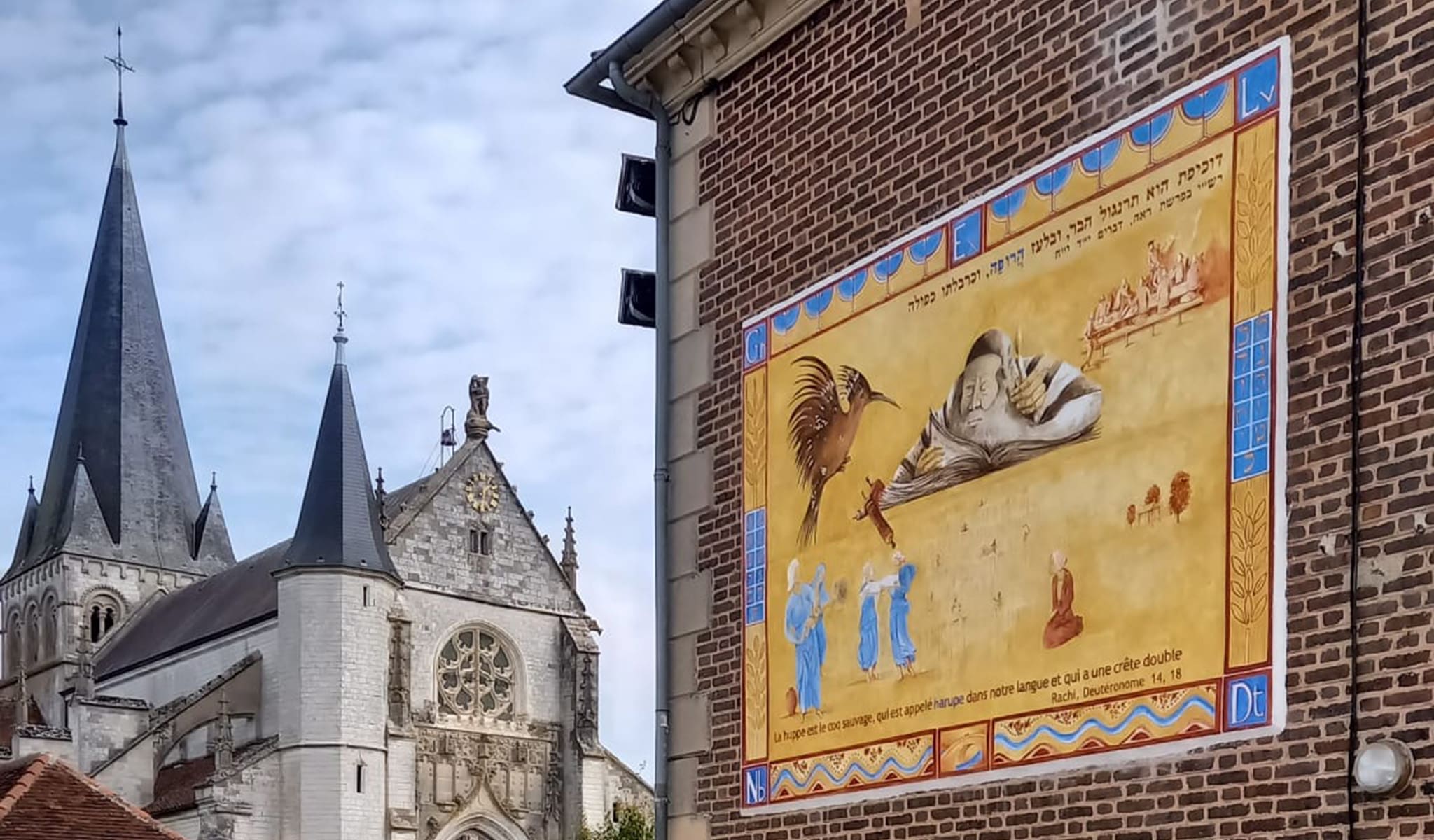
The fresco “Rachi, his disciples and his daughters”, created in September 2023, recounts and highlights the medieval Jewish heritage of Lhuître, where a Jewish community was established in the Middle Ages during the reign of the Counts of Champagne.
This fresco is the third in a slowtourism circuit, which will be extended over the next few years with the creation of several frescoes in around twenty other towns and villages in Aube. he written word, the fruit of the intellectual work bequeathed to us by the Sages of Champagne, is the common thread running through this “Rachi Course”.
With its original conception, this committed initiative puts the spotlight on rural communities through an unexpected collaborative historical, artistic, cultural, tourist and civic project that brings people together around strong values: sharing, intellectual openness, artistic curiosity, the fight against stereotypes, racism and anti-Semitism.
The Lhuître fresco measures 3.80m by 2.75m and is located on the wall of the Town Hall.
contact : bonjour@aube-champagne.com
What elements make up this fresco?
The medieval Jewish heritage of Champagne is largely intangible. Yet the commentaries of Rashi – a leading figure in medieval Jewish thought – and his disciples, the Tossafists (commentators from the School of Rashi), on the Bible and the Talmud are still studied throughout the world. The “Rachi Course”, supported by the Route Médiévale de Rachi en Champagne, is based on these historical figures who lived in local communities that provided fertile ground for meetings between Jewish and Christian communities sharing a common daily life. Their creativity was able to flourish, giving rise to writings that remain benchmarks today.
Hebrew meets Champagne, Judaism meets Champagne
To express these everyday, familiar exchanges, each fresco in the “Rashi Trail” contains a commentary by Rashi in Hebrew, translated into French. These commentaries include a wealth of accounts of local life at the time. Medieval French was the mother tongue of the Jews of Champagne. They used Hebrew for worship and the study of sacred texts and inserted French words into their commentaries to make them easier to understand for their readers and disciples. Through their comments, medieval French has crossed borders and centuries to become a major testimony to the beginnings of our language. These words are sometimes the oldest examples of terms transcribed into Old French and appear in many dictionaries. To illustrate this transmission of both history and language, the commentary chosen for Lhuître’s fresco focuses on the verse Deuteronomy 14, 12-18 from the Hebrew Bible:
“Here is [les animaux]that you will not eat: the eagle, the orfraie, the valerie, the falcon, the varieties of vultures, all crows, the ostrich, the swallow, the gull, the varieties of hawks, the owl, the hoot, the porphyrion, the pelican, the percnopter, the cormorant, storks, herons, hoopoes and bats. ». Rashi comments on this passage as follows: «The hoopoe is the wild cock, which is called a harup in our language and has a double crest.». This commentary by Rashi uses the word harupe in Old French, transcribed in Hebrew characters to translate the word hoopoe. The translation of the commentary has been adapted from several sources to make it easier to read and understand. This commentary confirms the link between medieval daily life in Champagne and the study of the biblical text by the Jewish communities present in the region.
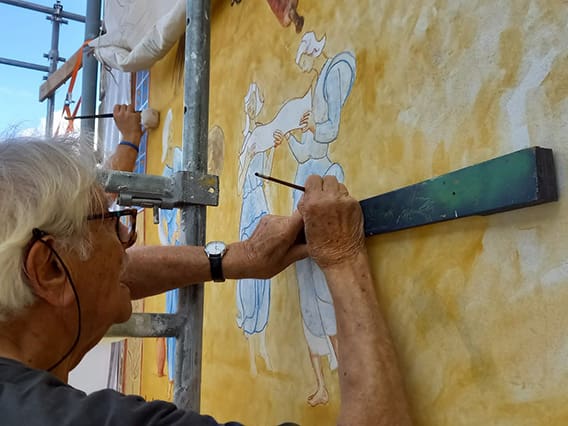
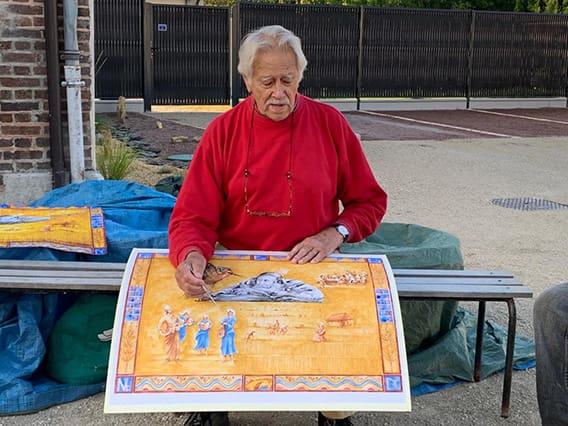
The narrative of the Lhuître fresco
To date, Lhuître is listed as one of the towns that was home to a medieval Jewish community. After Rachi, the famous commentator on the sacred texts of Judaism, his school spread throughout the county of Champagne from the 12th century onwards. In the 13th century, there were as many as 70 scholars in the area, who gave their credentials to the Talmud by drawing inspiration from Rashi’s method. No names of Tossafists or members of the Jewish community of Lhuître have come down to us to date. Alternatively, the fresco depicts Rashi, his wife and daughters and his disciples.
The characters
Rachi, who was born in 1040 and died in 1105, is shown here aged and serene, concentrating on a biblical passage he is deciphering. The artist has imagined a hoopoe whispering sacred words in his ear. The hoopoe became the symbol of the State of Israel in 2008. This bird, endemic to the Champagne region, was described by Rashi in the biblical verse of Deuteronomy 14, 18 and Leviticus 11, 19, as mentioned above. During his lifetime, Rachi taught some twenty students from northern France and beyond. They studied with the Master and were inspired by his new method of commentary before moving in turn to other territories to open a house of study where they passed on the teaching of Rashi and the words of Torah. Here, they are all represented together around a table of lively discussion. His wife, whose first name is not known, and his three daughters, Myriam, Yochebed and Rachel, appear in the foreground, a manuscript and musical instruments in hand, to show, as Professor and Rabbi Marc-Alain Ouaknin has suggested, the importance that Rashi gave to the study of women in his time. Her daughters were educated and learned. They were consulted on questions of biblical exegesis. The existence of his third daughter, Rachel, remains controversial according to some sources. On the same level, the patron saint of Lhuître, Saint Tanche, is another strong female figure in the area. Beheaded as a martyr in 637, she appeared in front of the chapel that bears her name and can be visited today. This representation of Jewish and Christian women on the same plane symbolises the meeting of Judaism and Christianity in the Champagne region. Jews and Christians shared the same language, the same trades and the same neighbourhoods until the 13th century, and their relations in the county of Champagne were quite favourable. All the characters symbolise the importance of study, faith and transmission.
They grew up around work in the fields, their main means of subsistence. The Lhuître region has a long history of farming, with wheat, vines and livestock. This is why it was decided to depict these strong symbols of local identity in different parts of the fresco.
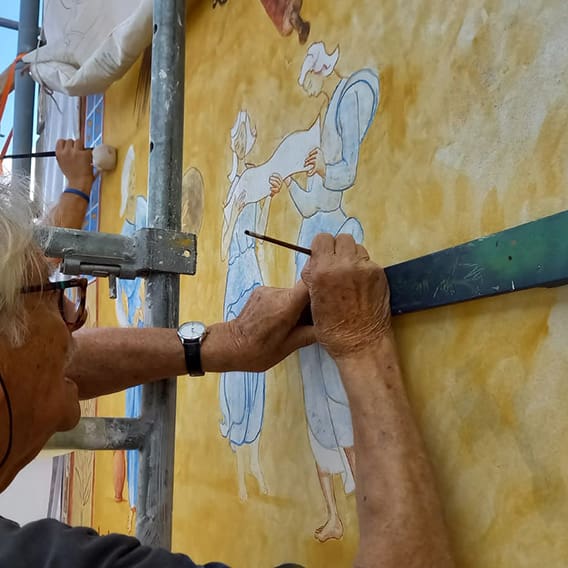
The content of the friezes
On the top banner, the menorah symbol is repeated 8 times. The menorah is a very ancient Jewish liturgical object meaning “candelabra”, described in the Bible in the chapter of Exodus 25, 21-37, whose creation was requested by God. It represents a biblical object that has also become a symbol of the State of Israel. It has 7 branches, like a tree that reaches for the sky with fruits of light that radiate outwards, “a tree of life that enlightens those who study” according to Rachi. The 7 branches are like the seven days of the week, with the Sabbath, the sacred day for the Jews, at the centre, lighting up all the others. In the fresco, the menorah is poetically suggested with just 3 branches.
The bands on both sides feature the Hebrew alphabet in a special font called “Ecriture Rachi”. The Hebrew alphabet has 22 letters. The Rashi typeface was used from the 16th century onwards to print the commentaries of Rashi and the Tossafists, in order to distinguish them from the so-called “square” typeface in which the sacred words of the Bible and the Talmud were printed, in order to distinguish them from the commentaries. Only Rachi and the Tossafists have since been printed in this specific typeface, which was inspired by an ancient Sephardic Hebrew cursive that predates Rachi. Around the alphabet, the ears of wheat are a reminder that they are one of the 7 fruits of Israel mentioned in the Bible, and also the symbol of local agriculture.
The Lhuitrelle, the river that flows through the village, runs along the lower ribbon. It is overlooked by bunches of grapes, which once grew in the region. A small stone bridge in the centre symbolises the link between past and present, the transmission of knowledge and the exchanges between Jews and Christians in the Middle Ages.
The origins of the Rachi Course
Since 2019, Champagne has been part of the Jewish Heritage Route, a Cultural Itinerary of the Council of Europe, as the cradle of a universally known and recognised intangible heritage. The mission of the Route Médiévale de Rachi en Champagne is to promote the Jewish memory of the department of Aube, a priceless cultural heritage shared by Jews the world over and the historical heritage of a leading region – the former County of Champagne – with national and international influence. However, there are no physical remains of where these communities lived. But the names of their representatives have crossed the centuries and borders and are known worldwide as the “Wise Men of Champagne”. The best-known artists lived in Ramerupt and Dampierre, two communes in the Arcis-Mailly-Ramerupt Communauté de Communes (CCAMR) in northern Aube, which explains the location of the first three frescoes.
The spirit of the Rachi
In the context of intangible heritage, the idea of illustrating the medieval Jewish heritage of Aube through permanent artistic works, free of charge and open to all, is intended to make this part of local history accessible to the general public and, as well as enabling people to discover the history of Aube, to gain a better understanding of Jewish heritage and culture in an informal way, by combining art and historical heritage in an entertaining way.
In this context, this slowtourism route makes sense from a tourist and cultural point of view, as well as from the point of view of promoting the region.
The project is free and open to all, locals and tourists alike, with a focus on forgotten local history. By involving local residents, and in particular schoolchildren, in its creation through a number of workshops, he has worked to gain recognition for this major local heritage and to combat anti-Semitism.
The role of the Scientific Council of the Medieval Route of Rashi in Champagne
The narration of the fresco was proposed by CulturistiQ Laboratoire Culturel and supervised by the Scientific Council of the Route médiévale de Rachi en Champagne, made up of a team of excellent researchers:
- Arnaud Baudin, Deputy Director of the Aube Archives and Heritage, Doctor of Medieval History
- Marc-Alain Ouaknin, Rabbi, writer and professor of philosophy and comparative literature at Bar-Ilan University (Israel)
- Pinchas Roth, Professor of Medieval Jewish History, Talmud Department, Bar Ilan University, specialist in Isaac de Dampierre
- Danièle Sansy, Senior Lecturer in Medieval History at the University of Le Havre Normandie
The team was assisted from time to time by Judith Kogel, Director of Research at the IRHT (Institut de Recherche et d’Histoire des Textes), and Professors Rami Reiner (Ben Gourion University) and Claire Soussen (Boulogne Côte d’Opale University and Director of the Nouvelle Gallia Judaica).
The members of the working group approved the narrative proposed by the Route médiévale de Rachi en Champagne on the theme of the “Memory of the Sages of Champagne”, which was based on a meeting between medieval Champagne symbolism and the symbolism of local Jewish heritage and history. The Scientific Advisory Board’s expertise was particularly sought to ensure that the historical details and symbolism were consistent, and to validate the choice of verse and the translation of the commentary on the fresco.
The Lhuître fresco. Art meets history
The model for the Lhuître fresco was created by renowned fresco artist Jean-Jacques Jolinon.
Introduced to working with lime by a grandfather who was a bricklayer, he has fond memories of his native Tunisia, where houses were painted in pastel colours. After living in the United States and Mexico, where he was impressed and seduced by the muralist movement, he has only one obsession: the rehabilitation and transmission of the fresco.
He moved to the Vienne in 1981, where he ran the fresco workshops at Saint-Savin-sur-Gartempe Abbey as part of the International Centre for Mural Art, until its closure in 2003. He continues to work on training projects at the Royal Abbey in Saint-Jean-d’Angély, at the Chambre des Métiers in Aurillac, and in secondary schools in Poitiers and Troyes.
It was in Saint-Jean-d’Angély that he met the teachers who, in 2003, founded the Passeurs de Fresques association, whose main aim is to pass on this ancestral art. It has been training them, accompanying them and supporting them in their actions for 20 years.
Alongside his work as a trainer, he has created a number of frescoes for private homes, at the Saline Royale d’Arc-et-Senans, in the entrance hall of Poitiers University Hospital, and in town halls (Saint-Savin sur Gartempe, Chauvigny).
In the Aube region, he has created and produced frescoes for the IUMP (Troyes, 2007), the socio-cultural hall at Faux-Villecerf (2010), the mill barn at Dosches (2013) and the former Bourse du Travail (Troyes, 2022).
The fresco was created by the Aube-based association “Les Passeurs de fresques“. The volunteers use this ancient art, which is a painting technique on fresh plaster made from air lime and river sand. The colours used are natural pigments, compatible with lime, simply diluted in water.
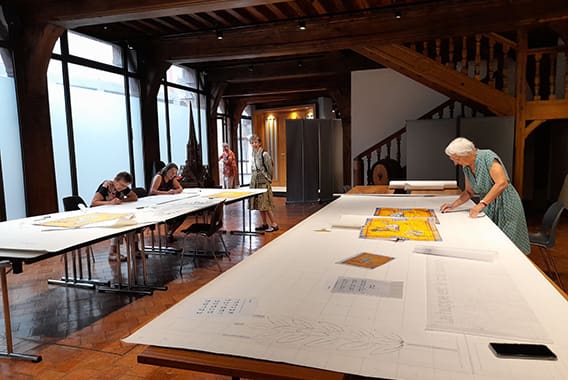
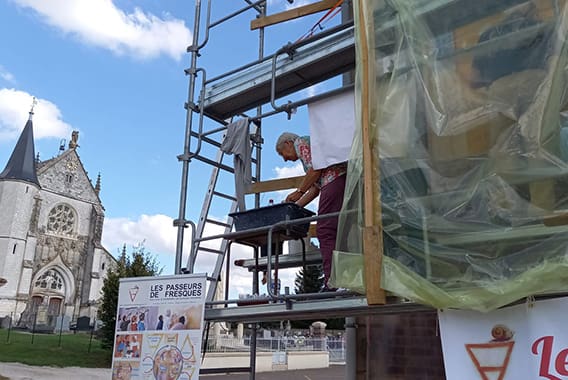
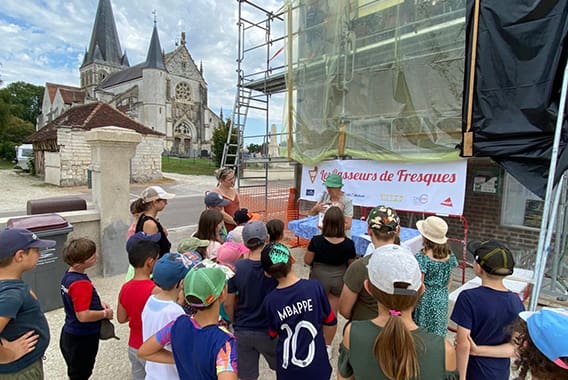
How is a fresco created?
Once the artist has produced a model of the fresco, the fresco artists enlarge it to scale. The plastic tracing paper used for this operation is then placed on the previously prepared wall and used to apply the line and then the desired pigments. An operation on a site such as the Dampierre fresco requires five full days of work on site, not including the preliminary work of enlarging the model and choosing the colours.
For more information: http://lespasseursdefresques.fr/
The Lhuître fresco project
The fresco project in Lhuître was led by the Communauté de Communes Arcis Mailly Ramerupt, in conjunction with the project in Dampierre and Ramerupt. The commune of Lhuître has shown a keen interest in enhancing its medieval heritage and has applied to create this third fresco in the Rachi Course.
Lime is a living material that adapts better to a healthy brick wall. The working group felt that the Town Hall’s solution met these criteria. The choice of a large-scale fresco, visible free of charge from the public highway, was unanimously approved.
Around ten volunteers were needed to create the fresco in situ. The fresco artists were provided with accommodation by the local council for the duration of the project. The works took place between 11 and 16 September 2023. Once two coats of lime had been applied, the work of transferring the design and then colouring the work began, using scaffolding erected by the local council.
Project partners
This project, led by the Arcis Mailly Ramerupt Community of Communes, attracted the attention of public and private institutions, which supported the creation of the fresco.
Au travers du concours d’Idées 2021 et 2022 organisé par l’Agence départementale de tourisme de l’Aube et de l’appui du Ministère de la Culture et du Conseil départemental de l’Aube, l’engagement de la Fondation pour la Mémoire de la Shoah, de la Fondation du Judaïsme Français et de la DILCRAH est significatif d’une reconnaissance historique, civique et pédagogique du projet.
